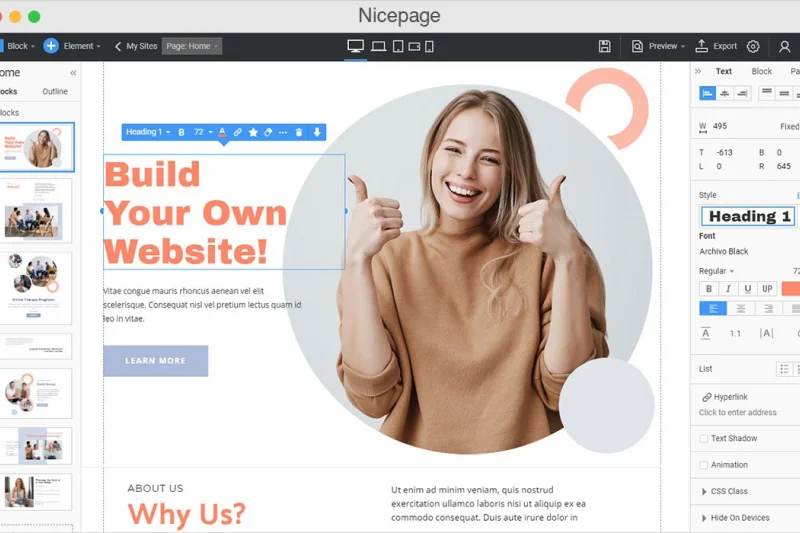Top 25 good home-based business ideas for 2025:
- eCommerce store
- Freelance writing
- Virtual assistance
- Online tutoring
- Print-on-demand
- Affiliate marketing
- Social media management
- Online consulting
- Content creation
- Dropshipping
- Handmade crafts
- Online courses
- Blogging
- Photography
- Web design
- SEO consulting
- Online fitness coaching
- Pet sitting and dog walking
- Event planning
- Online reselling
- Translation services
- Voiceover work
- Online surveys and market research
- Subscription boxes
- Digital marketing services
There are numerous opportunities for starting a home-based business today. At any given point, earning from the comfort of home has never been easier. While flexibility and low startup costs are enticing, a website is often crucial in establishing an online presence. The cost of a website ranges according to the type of business – some only need a domain name and hosting, while others may need an advanced marketing or eCommerce website. Knowing how much certain business activities cost, whether you are looking at business ideas from home or wondering how to start business from home, is crucial for staving off potential problems in the future.
1. Top 25 good home-based business ideas
Starting a home-based business offers flexibility, low overhead costs, and endless opportunities. Whether you’re selling products, offering services, or creating digital content, understanding the website cost for each business model is crucial. Below are 25 home business opportunities with low startup costs of “what kind of business can I start from home” with insights into their website requirements and potential expenses.
1.1. eCommerce store

One of the most profitable ideas for home based business is to start an eCommerce business. Hosting services such as GoSELL, Shopify, WooCommerce, Etsy, and BigCommerce make it easy for anyone to create a store. From Shopify, you can choose a monthly subscription of either $39 to $399. Etsy has a different approach by charging 6.5% in transaction fees per sale along with a 20¢ listing fee per product sold.
The charges for a standalone website differ greatly depending on the features required. A separate online store entails domain registration fees ($10 – $20 yearly), website hosting ($5 – $30 monthly), and premium themes ($50 to $300 for lifetime). Other costs include payment gateways which charge per transaction (2.9% for PayPal and Stripe), marketing costs, and inventory management software. If the user wants a complex site, they will pay anywhere from $500 to $5000 to hire a web developer for customization.
1.2. Freelance writing
Freelance writing is one of the easiest home businesses to commence as it does not require any funds. However, having a portfolio website can make a difference in attracting high-paying clients. Unfortunately, writers set up basic websites for freelance writing at a cost of $50 to $300 a year, which cover domain, hosting, and a professional theme.
Apart from these websites, writers also frequent Upwork and Fiverr, although these sites charge a 10-20% commission from each project. Some freelance writers consistently use SEO optimization tools paying monthly such as Grammarly Premium ($12/month) or Surfer SEO ($59/month) to help increase their content’s optimization and therefore, their earnings.
1.3. Virtual assistance
A virtual assistant (VA) is someone who offers administrative, technical or marketing help online. Most VAs find jobs on websites such as UpWork, PeoplePerHour, or Freelancer, but a webpage can advance one’s reputation and cultivate private clients.
A small website for a VA costs about a $100 to $500 and includes a domain, hosting, and design. Other costs may include project management systems (like Trello or Asana), email marketing tools ($10 – $50 per month), and advanced accounts on freelance services ($10 – $30 per month).
1.4. Online tutoring

The online education industry is booming, making online tutoring a lucrative home-based business. Tutors often use Zoom, Skype, or Google Meet for virtual classes, with premium plans costing $15 – $50 per month for advanced features.
A personal website for tutoring services costs $200 – $500 and may include scheduling tools like Calendly ($12/month) or learning management systems like Teachable or Thinkific ($39 – $199/month). Tutors offering pre-recorded courses need additional investments in video recording equipment and editing software.
1.5. Print-on-demand business
The print-on-demand model means that you can sell unique products without first buying stock inventory. Printful, Printify, and Redbubble manage the manufacturing and logistics for you and only charge after an order is filled. The only downside to this is that these sites charge a commission on each sale, resulting in fluctuating profits.
You can create your own print on demand site using GoSELL, Shopify or Woocommerce for between $200 and $1,000, which would include site design, hosting, advertising, and more. A large number of sellers also purchase Adobe Photoshop for $20/month or Canva Pro for $12.99/month for crafting the actual designs.
1.6. Affiliate marketing
Affiliate marketing is a passive income model where you earn commissions by promoting products. While some affiliate marketers use social media or YouTube, having a website increases credibility and SEO traffic.
Building an affiliate website costs $50 – $300 per year for hosting and domain. Many invest in SEO tools ($30 – $100/month) and email marketing services ($15 – $50/month) to grow their audience and increase conversions.
1.7. Social media management
Social media managers need an online presence to attract clients. A basic portfolio website costs $100 – $500. Many professionals find work through LinkedIn, Fiverr, or Upwork, which charge 10–20% in fees.
1.8. Online consulting
Websites assist consultants in exhibiting their work to prospective clients. Basic consulting websites range from $200 – $1,000, while tools like Calendly charge $12 – $30 per month.
1.9. Content creation

Bloggers, podcasters, and video makers are able to monetize their content through advertisements, sponsorships, and subscriptions. The website cost range for these content creators is $50 – $500 depending on premium features like video hosting, membership sites, and special integrations.
1.10. Dropshipping
Stores based on the dropshipping model can use Shopify, WooCommerce, or AliDropship. Shopify alone charges anywhere between $39 to $399 per month while WooCommerce is $200 – $1,000 for website design, hosting, and setup. Facebook and Google ads on the other hand have an extra expense of approximately $5 to $50 daily.
1.11. Handmade crafts
Selling handmade crafts online can be done through Etsy or a standalone website. Etsy offers built-in traffic but charges listing, transaction, and payment processing fees. In contrast, a self-hosted website via Shopify, WooCommerce, or Wix costs $200 – $1,500 for setup, hosting, and design but provides full control over branding and pricing.
1.12. Online courses
Instructors can use Teachable, Thinkific, or Kajabi for their students. This costs a base fee of $39 – $199 per month. A personalized course website can go anywhere between $500 – $2,000 for custom design, hosting, and marketing tools.
1.13. Blogging
Bloggers will need to buy a domain $10 – $20 a year as well as paid hosting plans at $5 – $30 a month. Ads, affiliate marketing, and sponsored content are the most popular ways to monetize.
1.14. Photography
Photographers use portfolio websites to sell prints and services. A photo website costs $100 – $500, while stock platforms like Shutterstock and Adobe Stock take 15 – 40% commissions per sale.
1.15. Web design

Freelance web designers can create a profitable home business opportunities with low startup costs by selling their services in web design and web maintenance. A portfolio website is important and spending on a domain, hosting and design ranges from $100 – $500. Most designers operate on freelance sites such as Upwork, Fiverr and Toptal that keep a 10-20% cut per project.
Web designers also buy premium website templates ($50 – $300), graphics softwares like Adobe Photoshop ($20/month), and coding tools like Visual Studio Code (free) and Sublime Text ($80 one-time).
1.16. SEO consulting
SEO consultants assist businesses with increasing their online visibility via keyword research, content optimization and creation, and backlinking. Everything revolves around the internet today, and having a website for an SEO service firm is quite mandatory – it can cost anywhere between $200 – $1,000 depending on the design and features needed.
Most SEO consultants spend the budget on premium SEO tools like Ahrefs, SEMrush, or Moz, which come at a monthly cost of $100 – $500. Some also implement Google Ads and social media marketing in their appeal to clients, increasing their advertising expenses by $5 – $50 a day.
1.17. Online fitness coaching
The emergence of online personal training programs offering virtual coaching has become a profitable business due to the availability of digital training programs. For live coaching sessions, instructors conduct classes over Zoom, Skype or Google Meet. Premium packages as of now are valued at $15 – $50 priced per month.
The expenses incurred in creating a personal coaching website rest between $200 – $500. Most coaching sites include essential scheduling capabilities through software like Calendly which costs $12 monthly. Furthermore, many coaches purchase video capturing peripherals, workout tracking software, and pre-recorded course hosting platforms that are priced between $39 – $199 per month.
1.18. Pet sitting and dog walking
Animal lovers will find it easy to set up a business from the comfort of their home as a dog walker or pet sitter. While some depend on services like Rover and Wag, which charge 15 – 20% commission fees, having a personal branded website will help generate more business from private clients.
Basic pet care websites, complete with a domain, hosting service, and branding, cost upwards of $100 – $300. Pet sitters may also decide to purchase liability insurance to guard against accidents, costing them around $100 – $300 a year.
1.19. Event planning
Event planners make sure corporate events, weddings, and other social events are well organized and executed. The price for creating a website that displays services is $200 – $1,000 based on design and capabilities.
Event planners often utilize digital ways to organize scheduling ($10 – $50/month) and project management tools (Asana, Trello, or HoneyBook for $10 – $40/month). The expenses on negotiations with vendors, social media advertising, and promotion ($5 – $50/day) bring in clientele.
1.20. Online reselling
The strategy of online reselling entails acquiring discounted products for later sales at higher prices. eBay, Amazon, and Poshmark have seller fees of 10% – 15% per sale.
Some resellers build a customized eCommerce store which can range from $300 – $1,000 to set up including domain, hosting, and payment processing. Other costs are inventory space and shipping charges.
1.21. Translation services
Bilingual entrepreneurs can start a translation services business from home. Many work through freelance platforms like Upwork, Fiverr, and PeoplePerHour, which take 10–20% of earnings.
Having a portfolio website costs $100 – $500, including hosting and branding. Some translators also invest in CAT tools (computer-assisted translation software) like SDL Trados or MemoQ, which range from $200 – $1,500.
1.22. Voiceover work

There is a rising need for voice over artists in business as they require voiceovers for their advertisements, videos, and audiobooks. Many Voice-over artists tend to work through Voices.com ($500 yearly membership), Fiverr, and Upwork. However, personal websites do assist in establishing direct connections with potential clients.
Having a voiceover website increases the chances of obtaining a direct audience from $100 to $500, while professional-grade equipment like microphones and audio editing applications such as Adobe Audition ($20 per month) cost an additional $100 to $500.
1.23. Online surveys and market research
One of the easiest ways to generate money working from home is by taking online surveys. Websites like Respondent, Swagbucks, and Survey Junkie pay for the completion of surveys but don’t necessitate a website.
Additionally, several market research companies do recruit survey participants using personal websites that generally have an estimated cost of $50 to $300. This business model works best when combined with affiliate marketing, focus group participation, or product testing services.
1.24. Subscription boxes
Subscription box businesses deliver curated products to customers on a recurring basis. Shopify and Cratejoy are the most popular eCommerce platforms for managing subscriptions, costing $39 – $99/month, plus transaction fees.
A custom subscription box website costs $300 – $1,000, including design, payment gateways, and branding. Additional costs include inventory management, packaging, and shipping logistics.
1.25. Digital marketing services
A website for branding costs $200 – $1,000. SEO, PPC, and social media marketing tools range from $50 – $500/month.
2. How to start a home-based business
A well-planned financial strategy is essential for launching a successful home-based business to start today. Key expenses include business registration, marketing, website construction, and workspace setup. While working from home reduces overhead costs, careful budgeting ensures a smooth launch and long-term stability.
By considering all necessary costs upfront, you can streamline the process and make how to start my own business from home more manageable and profitable.
2.1. Develop a business plan

The backbone of any most successful home-based businesses is well-crafted, structured, and articulated, and a home-based is no different. Everything ranging from defining the target audience, to financial estimates like expenses and costs to revenue, have to be planned out. If you are seeking any assistance from banks or investors, it is pertinent that you have a detailed business plan as well. Generally, entrepreneurs make use of free online business ideas models. However, some choose to hire a professional planner which can cost anywhere from $500 to $2,000, depending on the complexity of your services. Having a business plan will allow you to focus on your goals and manage your financials.
2.2. Choose a business structure
Having picked out a business structure determines your legal obligations, taxation obligations, as well as the ease in which you can run the company. For instance, sole traders are very common in home-based businesses, as this model is cost-effective and convenient.
However, the proprietor’s personal assets become exposed to business debts. If there is a need to protect personal liabilities, an LLC can be formed, with the business and personal assets being separated. The registration will cost anywhere between $50 and $500, depending on the state or country. Business owners intending to further grow the business and looking for potential investors usually go for a corporation as it is best suited for such expansions. While this option is considerably more costly to set up, ranging from $100 to $800, it also offers much stronger legal protection.
2.3. Obtain necessary licenses and permits
Depending on the kind of at-home business you decide to pursue, you may be required to have various licenses and permits. These are part of the legal requirements for operating a business at home. As with any business sector, an average business license will set you back by approximately $50 to $400. However, some industry-specific licenses, such as for food service or childcare, may cost upwards of $1,000. In some cases, local authorities may ask for a home occupation permit to ensure the home office complies to zoning regulations. This too comes at a price ranging from $50 to $200. Take the time to check on potential local government requirements to avoid legal issues down the road.
2.4. Set up a workspace
Creating a comfortable and efficien home office setup is essential for productivity. The cost of setting up a workspace depends on the type of business you run. If you already have basic equipment, expenses may be minimal. However, investing in an ergonomic desk and chair can cost $150 – $500, while a laptop or desktop computer for business use may range from $500 – $2,000. Additional costs include internet service, office supplies, and software subscriptions, which may add another $50 – $150 per month to your budget. Keeping these costs in check is important, especially for new businesses with limited funds.
2.5. Create a website

A website is one of the most crucial tools for running a home-based business, as it establishes credibility and helps attract customers. The website cost depends on the business model. A basic website for a freelancer, consultant, or writer may only require a domain name and hosting, which costs between $50 – $300 per year. However, an eCommerce store involves additional expenses, such as GoSELL, Shopify or WooCommerce platform fees, premium themes, and website development, which can range from $500 – $3,000. Some business owners also invest in SEO tools, plugins, and email marketing platforms, which can cost between $10 – $100 per month. If you are using freelance platforms like Upwork or Fiverr, you may not need a website initially, helping you reduce startup costs.
2.6. Market your business
Marketing is key to growing a home-based business, and there are both free and paid options. Social media marketing on platforms like Facebook, Instagram, and LinkedIn can be done for free, but running paid ads costs between $5 – $50 per day, depending on the platform and target audience. Investing in SEO and content marketing can drive organic traffic, but hiring a professional may cost between $100 – $1,000 per month. Other marketing expenses may include email marketing tools, branding, and graphic design services. To minimize costs, many new businesses start with organic marketing strategies and scale their advertising efforts over time.
3. Strategies for success in your home-based business

Running a home-based business comes with many advantages, but success depends on effective management and continuous improvement. From time management to financial tracking, mastering these strategies can help you stay organized and profitable.
3.1. Time management and productivity
Managing your time efficiently is crucial for any home-based business. Without a structured schedule, it’s easy to get distracted or overwhelmed. Using productivity tools like Trello, Asana, or Notion can help you plan tasks and stay on track. Some of these tools offer free versions, but premium features may cost $10 – $50 per month. Setting clear work hours and avoiding distractions will also improve productivity. When working from home, creating a dedicated workspace and setting daily goals can make a big difference in staying focused.
3.2. Financial management
Tracking income and expenses is essential for maintaining a profitable home-based business. Many entrepreneurs use accounting software like QuickBooks, FreshBooks, or Wave to manage finances. While some platforms offer free basic plans, advanced features may cost $10 – $50 per month. Proper financial management helps with budgeting, tax preparation, and ensuring that your home business remains sustainable. Keeping separate business and personal accounts can also simplify expense tracking and prevent financial confusion.
3.3. Networking and building relationships
Even though you work from home business, networking is key to growing a home-based business. Connecting with other entrepreneurs, potential clients, and industry professionals can open up new opportunities. Attending networking events, conferences, or business meetups may come with fees ranging from $20 – $500, depending on the event. Joining professional organizations or online communities related to your industry can also help build valuable relationships. Platforms like LinkedIn and Facebook groups offer free networking opportunities, making it easier to connect with like-minded professionals.
3.4. Continuous learning and adaptation
Staying updated with industry trends is essential for long-term success in any home-based business. Investing in online courses, workshops, or certifications can improve your skills and keep your business competitive. Websites like Udemy, Coursera, and LinkedIn Learning offer courses that range from $20 – $300. Many successful entrepreneurs dedicate time to learning about digital marketing for home businesses, social media strategies, and new business tools to stay ahead. Adapting to changes in technology and customer preferences ensures that your home-based business continues to grow.
4. Conclusion
Starting a home-based business is an exciting journey, but it requires careful planning and financial management. Key costs to consider include business registration, website setup, marketing, workspace expenses, and essential tools. While some businesses require minimal investment, others may need a website, paid advertising, or specialized software to operate efficiently.
The best time to start is now! The sooner you take action, the sooner you can build a thriving business on your terms. Need a reliable business management solution? Check out GoSELL to streamline your operations and grow your business effortlessly.
> Follow us on social media for the most recent news: Facebook / LinkedIn / X
5. FAQs
5.1. How much does it cost to start business from home?
The cost of starting a home-based business varies widely depending on the type of business. A freelance business may only require a domain name and hosting (around $50 – $300 per year), while an eCommerce store might need $500 – $3,000 for website setup, inventory, and marketing. Additional costs include business registration, marketing, workspace setup, and essential tools.
5.2. What are the most profitable home-based business ideas for 2025?
The most profitable home-based business ideas for 2025 depend on market demand, skills, and competition. Some top options include eCommerce stores, dropshipping, freelance writing, affiliate marketing, online tutoring, content creation, and digital marketing services. Businesses with low overhead costs and high scalability tend to be the most lucrative.
5.3. Do I need a business license to run a home-based business?
This depends on your location and the type of business. Some businesses, like freelance writing or consulting, may not require a license, while others, such as food-related businesses or home daycare services, may need specific permits and certifications. It’s important to check local government regulations to ensure compliance.
5.4. How can I market my home-based business effectively?
Marketing a home-based business involves both free and paid strategies. Social media marketing, content marketing, and networking are great low-cost marketing options. Paid strategies like Google Ads, Facebook Ads, and influencer collaborations can drive targeted traffic. Email marketing and SEO also help businesses attract long-term customers. A combination of organic and paid strategies is often the most effective.
5.5. Where can I find resources and support for starting a home-based business?
There are many online resources to help entrepreneurs start and grow their home-based businesses. Some useful platforms include:
- Small Business Administration (SBA) – Offers guides on business planning and funding options.
- SCORE – Provides free mentoring and business resources.
- Udemy, Coursera, and LinkedIn Learning – Great for learning new skills.
- Upwork, Fiverr, and Freelancer – Platforms for finding clients and building experience.



